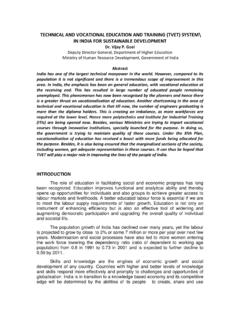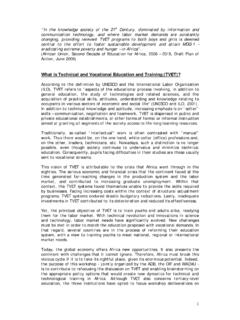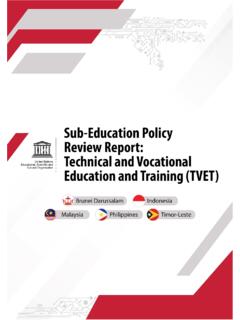Transcription of Technical and Vocational Education and Training (TVET ...
1 1 Technical and Vocational Education and Training (TVET) Challenges and Priorities in Developing Countries TITLE Technical and Vocational Education and Training (TVET) Challenges and Priorities in Developing Countries AUTHOR NAME AND AFFILIATION Moustafa Mohamed Moustafa Wahba; Competency Assurance & TVET Consultant Email: ABSTRACT The social and economic trends predicate the need for reforming the TVET Systems in different Developing Countries with a view to have a new development pattern which holds a culture of economically, environmentally and socially sustainable development. Keywords: TVET Challenges and Priorities in Developing Countries BACKGROUND The TVET in most of the Developing Countries is expected to play two crucial roles in the national sustainable development (social, economical & environmental development). The first role is to provide Training opportunities and career advancement avenues for the increased school leavers.
2 The second role is to provide skilled manpower that is needed at all levels of the economy. The skills so developed should be able to lead to self-reliance in the absence of salaried employment and enhance the industrialization process. Although TVET has been used by several Developing Countries as an instrument of sustainable development, TVET has been still left to the periphery and its significance has not really been embraced. On the other hand, Developing Countries have a relatively large percent of skilled yet unemployed people. This is as a result of declining employment in the public and private sector. Moreover, despite that Developing Countries have a large cheap unskilled labor force, as a result of lack of Education and Training , the core role of TVET in enhancing the informal sector and in offering skills and knowledge to the unskilled has not been keenly appreciated in most of the Developing Countries.
3 TVET administration in most of the Developing Countries is now increasingly being moved from the jurisdiction of the Ministries of Labor or Manpower Development to the Ministry of Industry and Ministry of Education and because of advancing aid harmonization in the Ministry of Education and Ministry of Industry, TVET has also come to be squarely cast within Education and industrial sectors development plans. In other words and by its very nature, the entirety of TVET does not fit within the frame of only one sector. In view of the learning and Education element, the TVET has to be administratively within the jurisdiction 2 of the Ministry of Education . In view of the powerful trends at work placing and the requirement for On-the-Job Training OJT and practical skilled workforce, the TVET should be also within the jurisdiction of the Ministry of Industry. For a TVET System to be able to play its role effectively, it is important to ensure that there exits an enabling and TVET friendly environment nationwide.
4 Such an enabling environment can be achieved by putting in place harmonized national TVET policies, provision of adequate funds, developing positive social attitudes towards Training and enhanced management. The increased public funding will increase the subsidy among the poor households through loans and bursaries to needy trainees. The governments and the private sector in different Developing Countries should above all recognize that TVET is an investment not a cost, with significant returns including the well being of workers, enhanced productivity, international competitiveness and economic growth in the long run. Enhanced management in different Developing Countries should ensure that TVET is well co-ordinate. This will reduce wastage of resources; improve relevance and retention of Training personnel in the country. Managing TVET under various government departments in most of the Developing Countries has result the TVET sector to be stagnated and cause disparities in the Training standards.
5 The current governmental plans in several Developing Countries such as Egypt, Tanzania, Liberia, Botswana, Zambia, South Africa, Kenya, Jordan and Syria have emphasized the development and promotion of TVET sector. Traditionally TVET was regarded to be a provision reserved for the male gender in Developing Countries. This belief has resulted in serious omissions in national government development plans where women are given a raw deal. Consequently, most of the TVET facilities are planned without taking into consideration the female gender. Coupled with this cultural belief among most of the communities in Developing Countries, women are discouraged from enrolling for Vocational career Training opportunities. Enrolment data from TVET institutions indicate that very low percentage of the women s total enrolment is in Vocational areas within Developing Countries.
6 This paper is aiming to specify the challenges facing the TVET System reform and identify the basic concepts of improving the quality of TVET delivery, improving of Training related affairs, delivering a TVET demand approach, assuring TVET institutional development, provision of capacity building instruments and transfer of Training technology in Developing Countries. This paper arises from practical observation that the significance of TVET in contributing to awareness, knowledge, skills and attitudes acquisition in Developing Countries is often ignored. Thus, the paper endeavors to discuss the current condition of TVET, in general, and underscore the importance of TVET in most of the Developing Countries today. The paper is also aiming to specify the challenges facing the TVET Reform Systems / Projects / Programmes, identify the basic concepts of improving the quality of TVET delivery, improving the Training related affairs, delivering a TVET demand approach, assuring TVET institutional development, provision of capacity building instruments and transfer of Training technology.
7 3 PROPOSED MODELS OR SOLUTIONS Introduction In most Developing Countries, the TVET refers to non-academic Technical Education and practical Training that develop the skills and knowledge of apprentices (learners of trades or crafts) working in different sectors of industry and trainees / students trained in different Technical Vocational institutes, centres and schools. The TVET is that part of the Education system that provides courses and Training programmes related to employment with a view to enable the transition from Secondary Education to work for young trainees / students (social objective) and supply the labor market with competent apprentices (economic objective). The TVET is used as a comprehensive term referring to those aspects of the educational process involving, in addition to general Education , the study of technologies and related sciences, and the acquisition of Knowledge, Practical Skills, and Attitudes relating to occupations in various sectors of economic and social life.
8 The TVET is further understood to be: a. An integral part of general Education b. A means of preparing for occupational fields for effective participation in the world of work c. An aspect of continuing or lifelong learning and a preparation for responsible citizenship d. An instrument for promoting environmentally sound sustainable development e. A method of facilitating poverty alleviation. The social and economic trends predicate the need for a new development pattern which holds a culture of economically, environmentally and socially sustainable development as its central features. Accordingly the values, attitudes, policies and practices of TVE in the Developing Countries must have their foundations in this pattern. Approaches and practices should be always sought for and presented to illustrate the contribution that TVET can make towards a more sustainable development. Challenges and Priorities Considering the myriad problems facing Developing Countries, TVET is not only important, it is a prerequisite.
9 We start by critically reviewing some of the problems and challenges facing the TVET and how TVET could be used to set priorities and alleviate these problems before embarking on suggestions on the way forward. The basic TVET System Reform Challenges and Priorities in Developing Countries listed in this paper is: A. Engaging Community as Significant Players in TVET In order to develop a nation s economy and society in different Developing Countries, it is important to note, that in average two thirds of the population in most of the Developing Countries generally work in jobs that require a skill level which is usually associated with Vocational Education and Training . It has been always a challenge to change the mindset of parents, the community and stakeholders about Vocational Education being second choice to academic Education . People tend to view TVET in a negative way, as Education and Training 4 meant for those who have failed in the society.
10 Most parents (even the ones with TVET background) want to see their children becoming engineers, doctors, lawyers, etc. just because they believe this will give them better job opportunities. This challenge is vital to development of TVET and it is apparently one of the major obstacles to improve the social status of TVET. If students who received a Vocational Education routinely earned better incomes than those who choose the academic route, then parents would factor this in their decision making. The challenge is to create Vocational programmes in Developing Countries that deliver professionally successful graduates. When we rise to this challenge, the brightest students will be fighting for a place on TVET schemes. In contrary to what is happening in Developing Countries, the employers and enterprises in most of the Developed Countries are queuing up to hire graduates of TVET programmes and there are more requests from employers and enterprises each year than there are graduates.

















